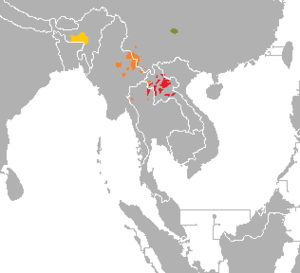Khmuic languages
The Khmuic languages are a branch of the Austroasiatic languages spoken mostly in northern Laos, as well as in neighboring northern Vietnam and southern Yunnan, China. Khmu is the only language in the group that has many speakers.
| Khmuic | |
|---|---|
| Geographic distribution | Indochina |
| Linguistic classification | Austroasiatic
|
| Proto-language | Proto-Khmuic |
| Glottolog | khmu1236[1] |
 Khmuic | |
Homeland
Paul Sidwell (2015)[2] suggests that the Khmuic Urheimat (homeland) was in what is now Oudomxay Province, northern Laos.
Languages
The Khmuic languages are:
- Mlabri (Yumbri)
- Phong (Kniang, Tay Phong)
- Ksingmul (Puok, Pou Hok, Khsing-Mul)
- Khmu’
- Khuen
- O’du
- Prai
- Mal (Thin)
- Theen (Kha Sam Liam)
There is some disagreement over whether Bit is Khmuic or Palaungic; Svantesson believes it is most likely Palaungic,[3] and it is sometimes placed in Mangic, but most classifications here take them as Khmuic. Similarly, Phuoc (Xinh Mul) and Kháng are also sometimes classified as Mangic, and Kháng is classified as Palaungic by Diffloth.
The recently discovered Bumang language is also likely a Khmuic or Palaungic language. Jerold A. Edmondson considers it to be most closely related to Khang. Also, Quang Lam is a poorly attested language in Vietnam that may be closely related to Kháng or Bit.
Classification
The interrelationships of these languages are uncertain. Ethnologue 19 classifies them as follows:
- Khmuic
A provisional classification at SEALang[4] keeps Mal–Phrai, but connects Khao with Khang instead of with Bit, treats Khuen as a dialect of Khmu':
Diffloth & Proschan (1989)
Chazée (1999), citing Diffloth & Proschan (1989), has the following:
- Khmuic
However, Gérard Diffloth now considers Pramic (i.e., all Khmuic languages except for Khmu) to be a separate Austroasiatic branch that has come under heavy influence from Khmu.[5]
Peiros (2004)
Ilia Peiros (Peiros 2004:39) has the following:
Sidwell (2014)
Based on developments of Proto-Khmuic *aː₁, Paul Sidwell (2014) classifies the Khmuic languages as follows.
- Khmuic
- Khmu
- Mlabri-Pram
The developments of Proto-Khmuic *aː₁ according to Sidwell (2014) are:
See also
References
- Hammarström, Harald; Forkel, Robert; Haspelmath, Martin, eds. (2017). "Khmuic". Glottolog 3.0. Jena, Germany: Max Planck Institute for the Science of Human History.
- Sidwell, Paul. 2015. The Palaungic Languages: Classification, Reconstruction and Comparative Lexicon. München: Lincom Europa.
- Ethnologue Report for Bit
- SEALang SALA: Southeast Asian Linguistics Archives
- Sidwell, Paul. 2018. Austroasiatic Studies: state of the art in 2018. Presentation at the Graduate Institute of Linguistics, National Tsing Hua University, Taiwan, May 22, 2018.
Further reading
- Chazée, Laurent. 1999. The Peoples of Laos: Rural and Ethnic Diversities. Bangkok: White Lotus.
- Cheeseman, Nathaniel; Paul Sidwell and Anne Osborne. 2017. Khmuic Linguistic Bibliography with Selected Annotations. JSEALS vol. 10 issue 1. pages i-xlvi.
- Filbeck, David. 1978. T’in: a historical study. Pacifijic Linguistics Series B-49. Canberra: Australian National University. [Includes a reconstruction of Proto-T’inic]
- Peiros, Ilia J. 2004. Geneticeskaja klassifikacija aystroaziatskix jazykov. Moskva: Rossijskij gosudarstvennyj gumanitarnyj universitet (doktorskaja dissertacija).
- Sidwell, Paul. 2014. "Khmuic classification and homeland". Mon-Khmer Studies 43.1:47-56
External links
- RWAAI (Repository and Workspace for Austroasiatic Intangible Heritage)
- http://hdl.handle.net/10050/00-0000-0000-0003-66E8-9@view Khmuic languages in RWAAI Digital Archive